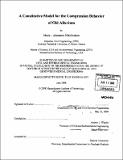| dc.contributor.advisor | Andrew J. Whittle. | en_US |
| dc.contributor.author | Nikolinakou, Maria-Aikaterini, 1976- | en_US |
| dc.contributor.other | Massachusetts Institute of Technology. Dept. of Civil and Environmental Engineering. | en_US |
| dc.date.accessioned | 2009-01-30T16:29:00Z | |
| dc.date.available | 2009-01-30T16:29:00Z | |
| dc.date.copyright | 2008 | en_US |
| dc.date.issued | 2008 | en_US |
| dc.identifier.uri | http://hdl.handle.net/1721.1/44291 | |
| dc.description | Thesis (Sc. D.)--Massachusetts Institute of Technology, Dept. of Civil and Environmental Engineering, 2008. | en_US |
| dc.description | Includes bibliographical references. | en_US |
| dc.description.abstract | Old Alluvium is classified as a transported, in-situ weathered tropical soil, and represents a class of geomaterials that have a complex microstructure, including cemented aggregates at the meso-scale and groups of clay stacks at the micro-scale. Despite the presence of significant fractions of nontronite (smectite species), the activity of charged clay particles is initially masked by the aggregation of iron oxides. Compression loading breaks the cementation at the meso-scale and causes physico-chemical changes at the micro-scale, which reveal the expansive characteristics of the clay minerals. It is difficult to achieve a fully disaggregated condition (through mechanical mixing or selective chemical dissolution) and hence, there is little practical value in referencing properties of the intact soil to a hypothetical disaggregated or intrinsic state as proposed for other bonded soils. The proposed formulation describes the variation of compressibility according to a measure of the microstructural changes using the Cation Exchange Capacity as a state variable. Upon load reversal, a model based on double layer theory is integrated to predict macroscopic volumetric expansion due to the swelling of the nontronitic clay fraction. This behavior is also linked to the Cation Exchange Capacity through the preconsolidation stress level, and hence, can accommodate changes in the clay swelling potential caused by mechanical or physicochemical loading. The model parameters depend on the compression characteristics of the intact soil, on measurements of the Cation Exchange Capacity in the intact and partially disaggregated states, on the amount of expandable minerals in the microstructure and on the initial hydration of the clay stacks. | en_US |
| dc.description.abstract | (cont.) Overall, the proposed formulation introduces a new way of modeling the compression of bonded materials with evolving microstructural characteristics, which does not require a unique reference state. It builds the swelling response directly on the physicochemical characteristics of the soil. The thesis also includes an experimental program on block samples obtained from a tunneling project in San Juan, Puerto Rico. The laboratory data was used for the calibration and detailed validation of model predictions. The proposed formulation enables predictions of expected engineering properties through the vertical weathering profile of the Old Alluvium. | en_US |
| dc.description.statementofresponsibility | by Maria-Aikaterini Nikolinakou. | en_US |
| dc.format.extent | 266 p. | en_US |
| dc.language.iso | eng | en_US |
| dc.publisher | Massachusetts Institute of Technology | en_US |
| dc.rights | M.I.T. theses are protected by
copyright. They may be viewed from this source for any purpose, but
reproduction or distribution in any format is prohibited without written
permission. See provided URL for inquiries about permission. | en_US |
| dc.rights.uri | http://dspace.mit.edu/handle/1721.1/7582 | en_US |
| dc.subject | Civil and Environmental Engineering. | en_US |
| dc.title | A constitutive model for the compression behavior of Old Alluvium | en_US |
| dc.type | Thesis | en_US |
| dc.description.degree | Sc.D. | en_US |
| dc.contributor.department | Massachusetts Institute of Technology. Department of Civil and Environmental Engineering | |
| dc.identifier.oclc | 272354519 | en_US |
